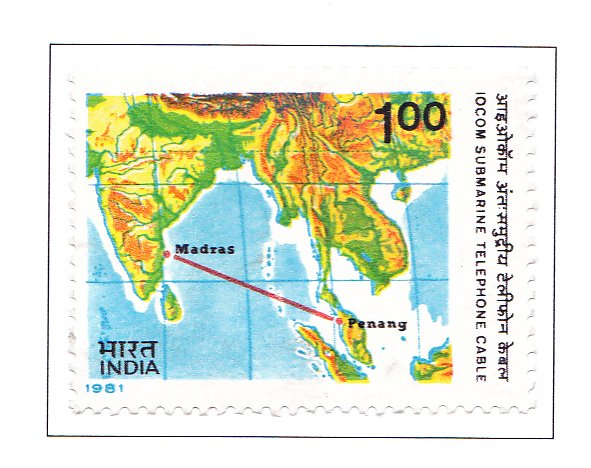Inauguration of IOCOM Submarine Telephone Cable

Technical Data
| Date of Issue | December 24, 1981 |
|---|---|
| Denomination | Rs. 1 |
| Quantity | 2,000,000 |
| Perforation | comb 13½ x 13 |
| Printer | Security Printing Press, Nashik |
| Watermark | No Watermark |
| Colors | Multicolor |
| Catalog Codes |
Michel IN 894 Stamp Number IN 948 Yvert et Tellier IN 695 Stanley Gibbons IN 1031 |
| Themes | Cartography | Maps | Telecommunication |
The history of telecommunications is intertwined with humanity’s quest to overcome the barriers of distance and the vast expanses of the oceans. For centuries, the seas presented formidable obstacles to the transmission of messages and the expansion of commerce. However, the invention of the telegraph in 1837 revolutionized long-distance communication, paving the way for the establishment of submarine telegraph cables.
In 1891, the first submarine telegraph cable, featuring a single circuit, was laid across the English Channel, connecting England and France. This pioneering achievement marked the beginning of a new era in global communication. Subsequent advancements in technology led to the laying of submarine cables with multiple circuits, such as the one between the Netherlands and Denmark in 1950, boasting 36 circuits.
One of the most significant submarine cable links spans the Atlantic Ocean, connecting Europe and the United States. Stretching over 3400 nautical miles, this cable system comprises an impressive 4000 voice-grade telephone circuits, facilitating extensive communication between the two continents.
Today, the world is interconnected by approximately 195 submarine cable links, covering a staggering 142 thousand nautical miles and supporting around 136,400 circuits. These submarine cable systems have witnessed a surge in development, serving as a vital component of global telecommunications infrastructure.
The emergence of modern wide-band submarine cable systems has complemented other communication technologies, including wireless and satellite systems. These high-capacity submarine cables play a crucial role in facilitating seamless and reliable communication across vast distances.
In the Indian Ocean Region, the establishment of the Indian Ocean Commonwealth Cable (IOCOM) marked a significant milestone in international telecommunications. Jointly initiated by seven Commonwealth countries – India, Sri Lanka, Malaysia, Singapore, Hong Kong, Australia, and Canada – the IOCOM spans 1350 nautical miles, linking Madras in India to Penang in Malaysia. With a capacity of 480 high-grade telephone circuits, the IOCOM represents India’s inaugural connection to the international submarine telephone cable network.
The inauguration of the IOCOM is a testament to the collaborative efforts of nations to enhance global connectivity and communication. The Indian Posts & Telegraphs Department commemorates this historic achievement with a special stamp, recognizing the importance of submarine cables in shaping the modern world of telecommunications.
